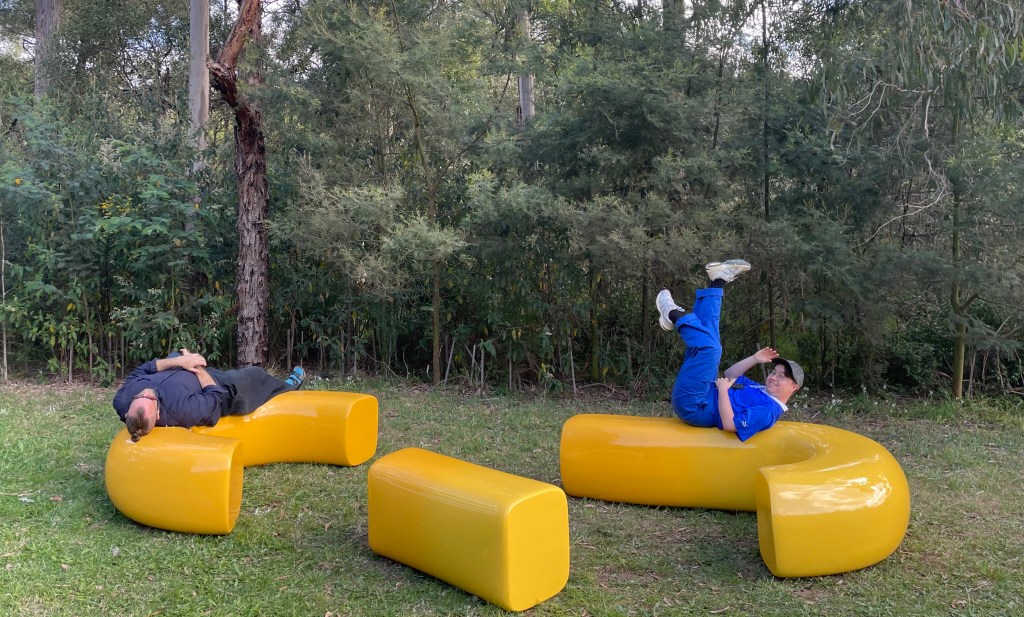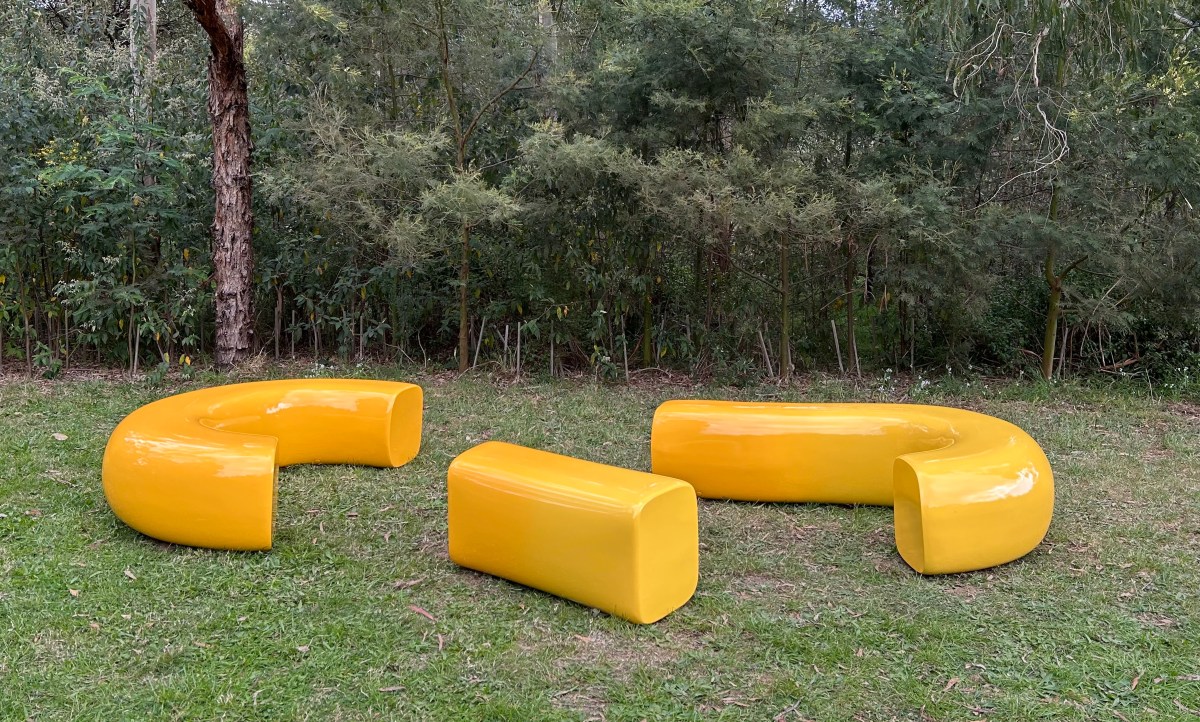A key part of acceptance is visibility. A new public art project – which has been spearheaded by Burrinja Cultural Centre – has brought together 12 young LGBTQIA+ people and multidisciplinary artist Tay Haggarty to create a publicly-placed sculpture that explores what it means to be a young queer person in 2023.
Titled Carabiner Bench (Nature found no fault with me), the sculpture will be unveiled at Birdsland Reserve, in Belgrave Heights in the Yarra Ranges, on 8 October. The temporary artwork is the result of a six-month long creative design and development process led by Haggarty.
The brightly coloured bench takes the form of a large carabiner, and is split into three sections, offering visitors a place to pause and reflect. Haggarty explains: ‘The history of the carabiner itself is quite important to the work. I’m a bit of a queer history nerd, and the carabiner is a historically charged symbol for queerness, representing a desire for connection and community.
‘So, the shape of the sculpture gives a nod to the past, and the efforts that have allowed us to get here,’ they add. The form, however, was not predetermined from the outset. ‘The use of the carabiner came up naturally in one of our workshops early on in our process, when the group was asked to bring in an affirming item,’ Haggarty says, explaining the process.
Burrinja designed the project to involve a co-design process between the leading artist and the collaborating young people in their EOI (Expression of Interest). In contracting Tay Haggarty Burrinja was delighted with their aligned values and Haggarty’s vision for the project. ‘We wanted it to be more than a public artwork outcome; we wanted there to be a series of workshops that supported social connection and creative expression. Tay understood this and had a similar vision, saying that they wanted to “create a micro-community” and that this was as important as the final piece itself,’ Gareth Hart, Burrinja CEO, tells ArtsHub.
Nature doesn’t judge
The project is part of Burrinja’s Queer Art Collective (QAC) facilitated by Gülsen Özer, aimed at developing new queer public art in non-metropolitan locations. Bucking the norm, which typically turns to mural art to deliver a community, co-designed artwork, the Carabiner Bench (Nature found no fault with me) is a major outcome of the QAC under the Big Connect Program.
‘Facilitated by queer people, for queer people, it is a project very close to my creative heart – knowing first-hand the lack of these spaces and opportunities in the outer eastern community I grew up in,’ says Hart.
In 2022, Burrinja was awarded a partnership with the Victorian Health Promotion Foundation (VicHealth), allowing it to bring together young LGBTQIA+ identifying people, and provide social connection through seeing, sharing, experiencing and making art.
Haggarty says that the public artwork is, ‘definitely a sculptural piece and a celebration of contemporary art, but it has a functionality’.
‘I want people to sit on it, and climb all over it, and sit beside each other in the carabiner’s embrace. It becomes a catalyst for connection.’
The yellow-orange colour scheme of the sculpture takes its cue from a heat map, and the kind of physical warmth that connection with another person can offer.
The site was also not predetermined at the start of the project.
‘It has actually come from the group. A lot of members spent time there during COVID as a kind of healing, mental health space,’ Haggarty explains to ArtsHub. ‘Queerness and nature was something that was brought up quite a lot throughout our workshops – what is “natural”? A lot of the group connected to the idea that nature doesn’t judge, that they can just be themselves. I think that is a really important part of the project as well.’
The bench as a site for connection will be extended with a series of activations over the length of its display, in particular through poetry. ‘Poetry popped up a few times in the workshops. It seemed to be something that the group was really excited by,’ says Haggarty. ‘I can’t wait to have us all sitting around the bench together reading poetry – it just melts my heart. It’s also going to be quite intergenerational, and I think it’s really special for young people to see a queer future, almost like themselves 20 years on within a community.’

Working collaboratively with a next generation of queer artists
Haggarty describes the project as a ‘really special opportunity’, but adds that it was hard work developing a collaborative project over a long period. ‘But the heart of this project is something I could never get sick of. I’ve learned a lot about communication, and so much from the young people themselves about accessibility and different needs when it comes to learning.’
They said the group of collaborators were, ‘unbelievably open-minded, talented and creative, and really generous in what they shared. I was completely blown away by them all’.
Haggarty continues: ‘The generation under me, they’ve just got it! And it just gave me so much confidence, moving forward, knowing that these beautiful minds were going out in the world.’
They describe the process as creating a micro community that works as a “safe bubble” for these youth. ‘That’s quite important, especially outside of the city. Creating a space that was geographically close to them, to express themselves and share their perspective and experiences, was something that was really important for me.’
Haggarty says they didn’t have a lot of access to queer culture growing up. ‘I didn’t know any openly out, queer people and I thought I was, for a second, the only one. So, this project was really special to me; it was quite healing, in a way.’
This comment is echoed by the project’s co-collaborators. ‘I can’t really fully put into words the value of QAC, as I’ve connected with peers and learned so much about, not only myself as a non-binary individual, but also the nuances of those around me – fellow artists, who all have their own perspectives and ways of creating,’ says Lachlan Wyness.
‘Taking part in the Queer Art Collective was really important to me because I got to form a community of other like-minded young queer people from all different creative backgrounds. And it helped to bring some inspiration and juice back into my own art,’ adds Zeth Cameron.
The broader QAC program, which includes monthly events and workshops, has brought together hundreds of LGBTQIA+ people and their families over the past 18 months.
Haggarty concludes: ‘I’m so stoked that we’ve finally installed the bench. But even more than that, it’s incredibly bold to put a project out like this, and it’s been such a joy to work on with Burrinja.’
You can view Carabiner Bench (Nature found no fault with me) from 8 October through to 15 December. The sculpture is located at Birdsland Reserve, lower car park, 271 Mount Morton Road, Belgrave Heights.
An opening event with live performances will be held Sunday, 8 October, 1-2pm, followed by Queer Art (after)Party at Burrinja from 3pm.
A full public program and live poetry readings will also be presented on Saturday 28 October, 2-4pm.
LGBTQIA+ people of all ages are invited to read a self-written poem or listen to others at this intergenerational poetry reading. The event is open to all community and LGBTQIA+ allies to attend.





